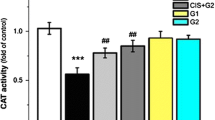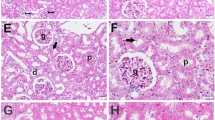Abstract
Cisplatin is an antitumor drug widely used in the treatment of many malignant tumors. However, the most common adverse effect, nephrotoxicity, limits the use of this drug in many cancer patients. Resveratrol is a phytoalexin that presents highly efficient protection in experimental nephrotoxicity models. This study evaluated the effect of resveratrol on cisplatin-induced kidney damage. Male Wistar rats were treated with resveratrol (25 mg/kg b.w., i.p.) before the administration of cisplatin (5 mg/kg b.w., i.p.) and killed 2 or 5 days later. Blood and urine samples were collected and the kidneys were removed. Rats from the cisplatin group showed acute tubular cell necrosis and increased immunostaining for ED1 (macrophages/monocytes) and T-lymphocytes in the renal cortex and outer medulla when compared with the control group. These alterations were less intense in animals pre-treated with resveratrol. Moreover, indicators of renal injury such as increased serum creatinine levels, urinary volume and urinary protein caused by the administration of cisplatin, were also significantly reduced with resveratrol. Increased lipid peroxidation and glutathione depletion in tissue were attenuated by resveratrol. In conclusion, resveratrol attenuated the cisplatin-induced structural and functional renal changes by reducing free radicals and inhibiting inflammatory cell infiltrates.

Similar content being viewed by others
Abbreviations
- ATN:
-
Acute tubular necrosis
- cDDP:
-
Cisplatin
- GSH:
-
Reduced glutathione
- MDA:
-
Malondialdehyde
- Res:
-
Resveratrol
- ROS:
-
Reactive oxygen species
References
Antunes LMG, Darin JD, Bianchi MLP (2000) Protective effects of vitamin C against cisplatin-induced nephrotoxicity and lipid peroxidation in adult rats: a dose dependent study. Pharmacol Res 41:405–411
Asensi M, Medina I, Ortega A, Carreteiro J, Baño MC, Obrador E, Estrela JM (2002) Inhibition of cancer growth by resveratrol is related to its low bioavailability. Free Radic Biol Med 33:387–398
Atessahin A, Yilmaz S, Karahan I, Ceribasi AO, Karaoglu A (2005) Effects of lycopene against cisplatin-induced nephrotoxicity and oxidative stress in rats. Toxicology 212:116–123
Aydinoz S, Uzun G, Cermik H, Atasoyu EM, Yildiz S, Karagoz B, Evrenkaya R (2007) Effects of different doses of hyperbaric oxygen on cisplatin-induced nephrotoxicity. Ren Fail 29:257–263
Badary OA, Abdel-Maksoud S, Ahmed WA, Owieda GH (2005) Naringenin attenuates cisplatin nephrotoxicity in rats. Life Sci 76:2125–2135
Baroni EA, Costa RS, Da Silva CGA, Coimbra TM (2000) Heparin treatment reduces glomerular injury in rats with adriamycin-induced nephropathy but does not modify tubulointerstitial damage or the renal production of transforming growth factor-beta. Nephron 84:248–257
Behling EB, Sendão MC, Francescato HDC, Antunes LMG, Costa RS, Bianchi MLP (2006) Comparative study of multiple dosage of quercetin against cisplatin-induced nephrotoxicity and oxidative stress in rat kidneys. Pharmacol Rep 58:526–532
Bonventre JV, Zuk A (2004) Ischemic acute renal failure: an inflammatory disease? Kidney Int 66:480–485
Bradford MM (1976) A rapid sensitive method for the quantitation of microgram quantities of protein utilizing the principle of protein–dye binding. Anal Biochem 72:248–256
Camargo SMR, Francescato HDC, Lavrador MAS, Bianchi MLP (2001) Oral administration of sodium selenite minimizes cisplatin toxicity on proximal tubules of rats. Biol Trace Elem Res 83:251–262
Chander V, Chopra K (2006) Protective effect of nitric oxide pathway in resveratrol renal ischemia-reperfusion injury in rats. Arch Med Res 37:19–26
Chander V, Tirkey N, Chopra K (2005) Resveratrol, a polyphenolic phytoalexin protects against cyclosporine-induced nephrotoxicity through nitric oxide dependent mechanism. Toxicology 210:55–64
Choie DD, Longnecker DS, Campo AA (1981) Acute and chronic cisplatin nephropathy in rats. Lab Invest 4:397–402
Dobyan DC, Levi J, Jacobs C, Kosek J, Weiner MW (1980) Mechanism of cis-platinum nephrotoxicity: II. Morphologic observation. J Pharmacol Exp Ther 213:551–556
Dong Z (2003) Molecular mechanism of the chemopreventive effect of resveratrol. Mutat Res 523–524:145–150
Dong Z, Atherton SS (2007) Tumor necrosis factor-α in cisplatin nephrotoxicity: a homebred foe? Kidney Int 72:5–7
Francescato HDC, Coimbra TM, Costa RS, Bianchi MLP (2004) Protective effect of quercetin on the evolution of cisplatin-induced acute tubular necrosis. Kidney Blood Press Res 27:148–158
Giovannini L, Migliori M, Longoni BM, Das DK, Bertelli AA, Pancichi V, Filippi C, Bertelli A (2001) Resveratrol, a polyphenol found in wine, reduces ischemia reperfusion injury in rat kidneys. J Cardiovasc Pharmacol 34:262–270
Hartree E (1972) Determination of protein: a modification of long method that gives a linear photometric response. Anal Biochem 48:422–427
Iseri S, Ercan F, Gedik N, Yuksel M, Alican I (2007) Simvastatin attenuates cisplatin-induced kidney and liver damage in rats. Toxicology 230:256–264
Kishore BK, Krane CM, Di Iulio D, Menon AG, Cacini W (2000) Expression of renal aquaporins 1, 2, and 3 in a rat model of cisplatin-induced polyuria. Kidney Int 58:701–711
Kolgazi M, Sener G, Cetinel S, Gedik N, Alican I (2006) Resveratrol reduces renal and lung injury caused by sepsis in rats. J Surg Res 134:315–321
Kruidering M, Walter BV, Heer E, Mulder GJ, Nagelkerke JF (1997) Cisplatin-induced nephrotoxicity in porcine proximal tubular cells: mitochondrial dysfunction by inhibition of complexes I to IV of the respiratory chain. J Pharmacol Exp Ther 280:638–649
Kuhnle G, Spencer JP, Chowrimootoo G, Schroeter H, Debnam ES, Srai SK, Rice-Evans C, Hahn U (2000) Resveratrol is absorbed in the small intestine as resveratrol glucuronide. Biochem Biophys Res Commun 27:212–217
Liu M, Chien C, Burne-Taney M, Molls RR, Racusen LC, Colvin RB, Rabb H (2006) A pathophysiologic role for T-lymphocytes in murine acute cisplatin nephrotoxicity. J Am Soc Nephrol 17:765–774
Lu Y, Kawashima A, Horii I, Zhong L (2005) Cisplatin-induced cytotoxicity in BSO-exposed renal proximal tubular epithelial cells: sex, age, and species. Ren Fail 27:629–633
Marier JF, Vachon P, Gritsas A, Zhang J, Moreau JP, Ducharme MP (2002) Metabolism and disposition of resveratrol in rats: extent of absorption, glucuronidation, and enterohepatic recirculation evidenced by a linked-rat model. J Pharmacol Exp Ther 302:369–373
Morales AI, Buitrago JM, Santiago JM, Fernandez-Tagarro M, Lopez-Novoa JM, Perez-Barriocanal F (2002) Protective effect of trans-resveratrol on gentamicin-induced nephrotoxicity. Antioxid Redox Signal 4:893–898
Nihei T, Miura Y, Yagasaki K (2001) Inhibitory effect of resveratrol on proteinuria, hypoalbuminemia and hyperlipidemia in nephritic rats. Life Sci 68:2845–2852
Rezk YA, Balulad SS, Keller RS, Bennett JA (2006) Use of resveratrol to improve the effectiveness of cisplatin and doxorubicin: study in human gynecologic cancer cell lines and in rodent heart. Am J Obstet Gynecol 194:e23–e26
Saad SY, Najjar TA, Alashari M (2004) Role of non-selective adenosine receptor blockade and phosphodiesterase inhibition in cisplatin-induced nephrogonadal toxicity in rats. Clin Exp Pharmacol Physiol 31:862–867
Safirstein R, Miller P, Dikman S, Lyman N, Shapiro C (1981) Cisplatin nephrotoxicity in rats: defect in papillary hypertonicity. Am J Physiol 241:F175–F185
Saito M, Satoh S, Kojima N, Tada H, Sato M, Suzuki T, Senoo H, Habuchi T (2005) Effects of a phenolic compound, resveratrol, on the renal function and costimulatory adhesion molecule CD86 expression in rat kidneys with ischemia/reperfusion injury. Arch Histol Cytol 68:41–49
Sean Eardley K, Cockwell P (2005) Macrophages and progressive tubulointerstitial disease. Kidney Int 68:437–455
Sedlak J, Lindsay RH (1968) Estimation of total, protein-bound, and nonprotein sulfhydryl groups in tissue with Ellman’s reagent. Anal Biochem 25:192–205
Shimeda Y, Hirotani Y, Akimoto Y, Shindou K, Ijiri Y, Nishihori T, Tanaka K (2005) Protective effects of capsaicin against cisplatin-induced nephrotoxicity in rats. Biol Pharm Bull 28:1625–1638
Silan C, Uzun O, Comunoglu NU, Gokcen S, Bedirhan S, Cengiz M (2007) Gentamicin-induced nephrotoxicity in rats ameliorated and healing effects of resveratrol. Biol Pharm Bull 30:79–83
Uchiyama M, Mihara M (1978) Determination of malonaldehyde precursor in tissues by thiobarbituric acid test. Anal Biochem 86:271–278
Vitrac X, Bornet A, Vanderlinde R, Valls J, Richard T, Delaunay JC, Mérillon JM, Teissédre PL (2005) Determination of stilbenes (δ-viniferin, trans-astrigin, trans-piceid, cis- and trans-resveratrol, ε-viniferin) in Brazilian wines. J Agric Food Chem 53:5664–5669
Wenzel E, Somoza V (2005) Metabolism and bioavailability of trans-resveratrol. Mol Nutr Food Res 49:472–481
Yamate J, Machida Y, Ide M, Kuwamura M, Sawamoto O, Lamarre J (2004) Effects of lipopolysaccharide on the appearance of macrophage populations and fibrogenesis in cisplatin-induced rat renal injury. Exp Toxicol Pathol 56:13–24
Ysebaert DK, De Greef KE, De Beuf A, Van Rompay AR, Vercauteren S, Persy VP, De Broe ME (2004) T cells as mediators in renal ischemia/reperfusion injury. Kidney Int 66:491–496
Acknowledgments
This study was sponsored by the Conselho Nacional de Desenvolvimento Científico e Tecnológico––CNPq. The authors thank Quiral Química do Brasil (Juiz de Fora, Brazil) for their generosity in supplying cisplatin for free. The authors are also grateful to Mrs. Adriana L. G. de Almeida (FMRP-USP) and Mrs. Erica Delloiagono (FMRP-USP) for their technical assistance.
Author information
Authors and Affiliations
Corresponding author
Rights and permissions
About this article
Cite this article
Do Amaral, C.L., Francescato, H.D.C., Coimbra, T.M. et al. Resveratrol attenuates cisplatin-induced nephrotoxicity in rats. Arch Toxicol 82, 363–370 (2008). https://doi.org/10.1007/s00204-007-0262-x
Received:
Accepted:
Published:
Issue Date:
DOI: https://doi.org/10.1007/s00204-007-0262-x




